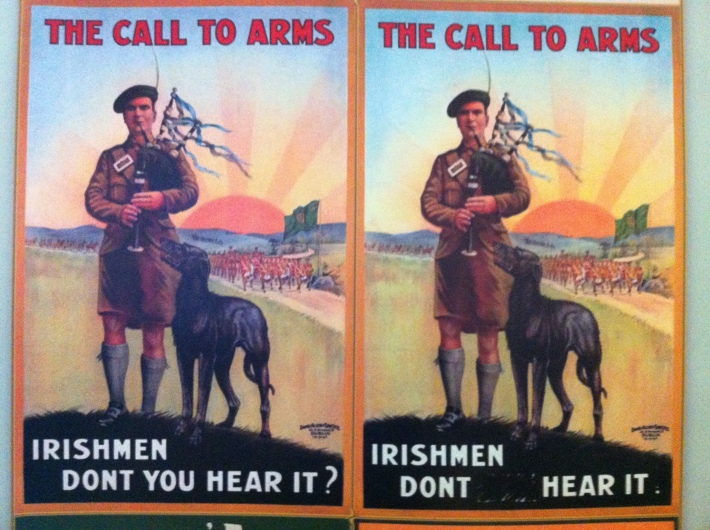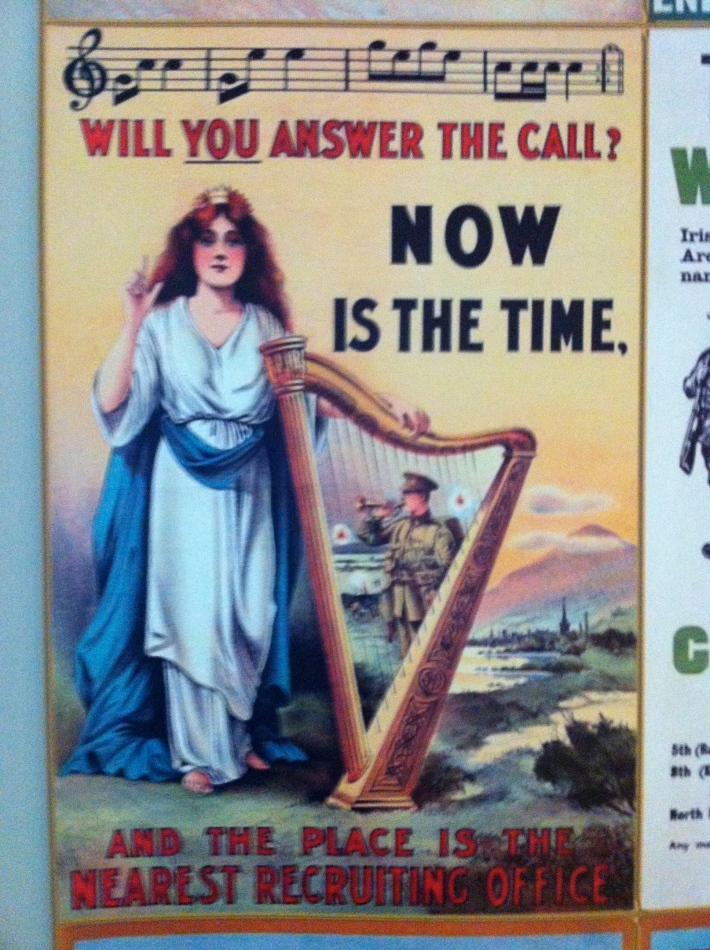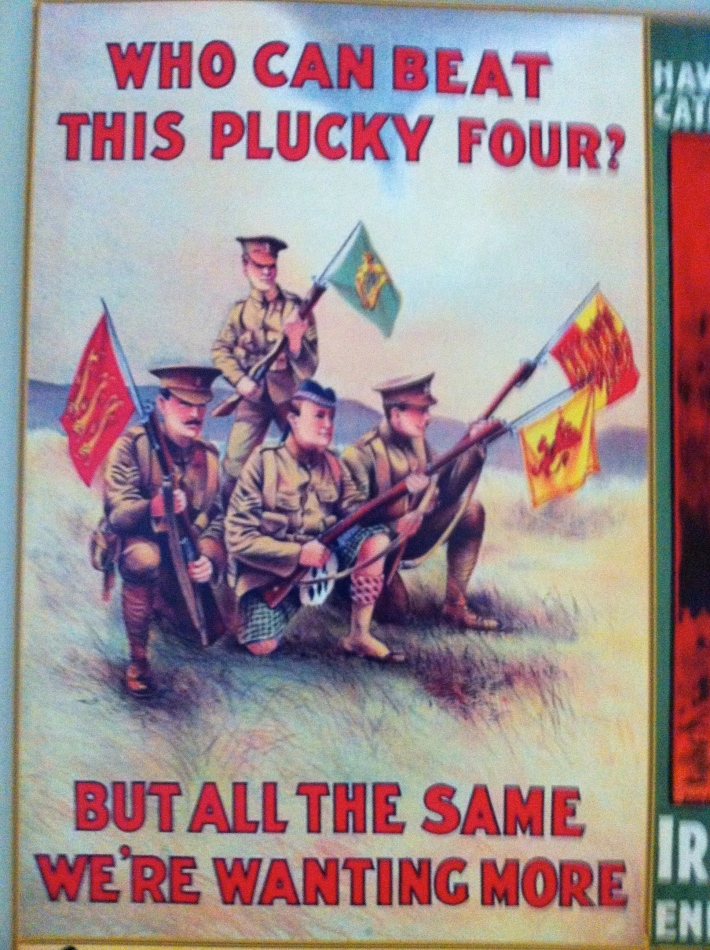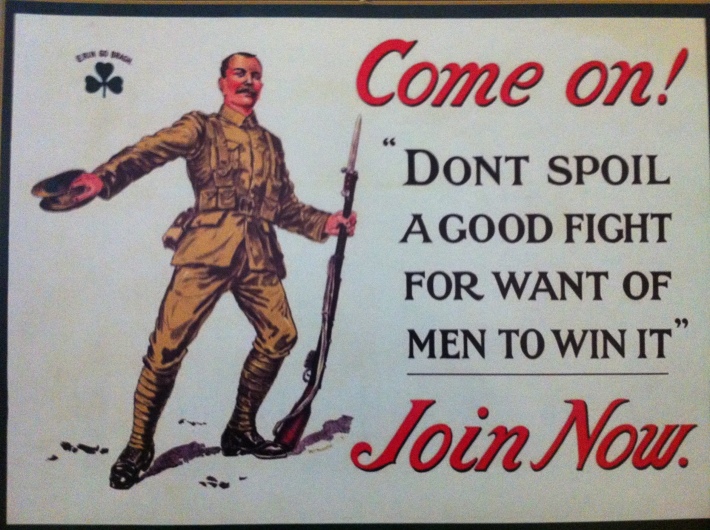First World War recruitment pictures. From an exhibition last year at the National Museum at Collins Barracks, Dublin. All of these posters (bar one, aimed at Irish exiles in the North of England) were used around Ireland during the First World War to drive recruitment. To mark the approach of the onset of World War I and raise funds for Focus Ireland, we’re doing a WWI walk 30th March. Meet point is the Campanile in Front Square, Trinity College, at 1.45 pm tomorrow 30th March. Suggested contribution €15, all proceeds go to Focus Ireland. Join us there. Right, back to 1914-18! Although Ireland this period was of course still a part of the UK, for very specific political reasons, unlike England, Scotland and Wales, it did not have conscription imposed on it. Hence the need to recruit, and these posters of course. Despite that lack of compulsion, for all sorts of complex and varied reasons, many many tens of thousands of Irish men were prepared to, indeed did volunteer and serve. These images sought to encourage that “impulse”.
Over 200,000 went in the end, dwarfing the numbers who fought, for example in the Easter Rising 1916 or even the Irish War of Independence.
as you see from the two examples above, some posters sought – through colour, and various emblems and devices- to emphasize the “Irishness” of the individual men, and the regiments, fighting in Northern France, Flanders, Gallipoli and elsewhere at that awful time.
I have no inside information on this, but we could hazard a guess that these particular type of posters were considered safer and less contentious in those areas of Ireland where people were pretty sick of the English. A vast majority, around 80% – of Irish people wanted Home Rule at this stage. (Many had been voting for it and campaigning for it for generations)
Another category of poster (above) acknowledged (even celebrated, albeit in highly simplistic terms) the distinctive traditions of the disperate parts of Ireland, England, Scotland & Wales. But at the same time it also sought to emphasize the essential unity and “togetherness” of the parts, standing shoulder to shoulder of course, putting aside “minor” differences, in order to concentrate on the real business in hand- fighting the beastly Hun. This poster above therefore, may have “played” better in (mostly) staunch Belfast, rather than, say, West Cork and Kerry, which were (in general) far more Nationalist in outlook.
Another category of poster (as I see it) simply sought to appeal to the manly virtue of the reader. It more or less says: “Go on, have an adventure; there’s a great scrap on; don’t be a bloody whimp” (are you a man or a mouse? etc… ) Given our much changed culture and also what we know now about the carnage and horrors of WWI, this might seem daft. But one should not underestimate the changes in culture and mindset wrought by the last 90 years. Men, and especially young men, were indeed bred, educated and primed for tremendous risk-taking, sacrifice and the rest. – Dulce et decorum est pro patria mori… and all that.
This other poster, just below, plays on much the same emotions…
Regiments, units and battalions were of course organized and recruited on a regional basis. I was interested to see this map-poster, above, clearly showing the boundaries for army/regimental purposes in Ireland. The name of nearly all these regiments are still remembered. Let’s jus take one, albeit very distinguished example, Anyone who read my post on the Anglican church of Saint Nicholas Of Myra, in Galway, will know its the regimental chapel of the Connaught Rangers. They fought from Napoleonic times until after WWI. Just checking their Battle honours even on Wikipedia maks it clear just how integral Irish officers and men were to the British army and (by extension) to British power and British colonialism. Among others, these battle honours include soldiering in the Peninsula campaign (in Spain, against Napoleon) in Egypt, South America, the Battle of Toulouse, the Indian Mutiny, the Zulu War, aand the first Boer War. A few small detachments were sent to Crimea, where individual troopers may have participated in the Charge of the Light Brigade.
I also see that when they were in Africa some went on the Gordon Relief Expedition, (on camels apparently) As we know they arrived too late to save poor Gordon. I also see they also took part in the Dongola Expeditionary Force, as part of Lord Kitchener’s reconquest of the Sudan. Obviously, later, they fought in that mother of all wars, WWI. Anything for a quiet life, eh?
We mentioned at the head of this piece that all of the posters were plastered around Ireland,bar one. Here above is the exception. As you see it is from Tyneside, in other words from Newcastle in the north of England. I don’t pretend to be an expert but I see that the Tyneside Irish were an infantry brigade raised along the lines of the “Pals Battalions” – in other words from among closely connected communities. In this case it was from the men in the Newcastle area of Irish extraction. (there would have been many thousands of Irish origin or Irish extraction, and of course the same story in London, Liverpool, Manchester, Glasgow and so on) This particular regiment was all but wiped out, many, many hundreds of them, as part of that epic tragedy known as the Battle of the Somme. (July-November, 1916) It lost so many men the regiment was effectively disbanded. One can imagine what this loss did for the Newcastle-Irish community.(or ratherof course, one can not imagine ) Naturally the same obliteration was happening to hundreds of other regiments across the army, of other Pals regiments, other communities, from all regions and nationalities, English, Irish, Welsh and Scots. The British army, which had originally used the Pals Regiments as a very successful recruitment ploy, abandoned it when it became clear that some communities had lost nearly all their men.
Heard enough? Okay, here are just two more for you.
Look at this little exhibit above. Bear in mind that 80% of Irish people were pretty sick of British rule in Ireland, a big majority wanted Home Rule at the very least, and there was a radical but significant minority who demanded nothing less than a full, seperate, independent Irish Republic. In such an atmosphere, appeals to a hearty “Let’s all be British-together” type-spirit were unlikely to go down well. And the army knew it. But they also knew the majority of Irish people were devout Catholics. So, what better than a picture of Catholic church or cathedral in Catholic Flanders, “desecrated” by the filthy Godless Hun? There were also plenty of lurid reports in the newspapers, about the hun raping Belgian and French nuns. Also- (I seem to recall form school history) news reports of them impaling people on their bayonets (orphans, kittens and puppies as well probably) to go along with this sort of poster. This sort of propaganda very often had the desired effect. It drove recruitment. Most of it was nonsense. Or lies in fact. However, the Germans did, definitively, commit atrocities in Belgium and France, including shooting unarmed civilians.
In the end…
So many soldiers were killed that the army had to keep up their recruiting drive. Most British people still belived in the War, although they were weary and sick of it, and sickened by the loses. There was more skepticism in Ireland, which was naturally more distinct, and more politicised, even radically politicised, than other parts of the British Isles. But there was another factor, tragically, that kept Irishmen volunteering, and that was simple economic necessity. Ireland was far less industrially developed than other parts of the British Isles. (Partly, it has to be said, as a result of English trade laws imposed in the 17th and 18th century) Fighting could mean you died in a cold, muddy field, trapped on some barbed wire while the germans shot you to pieces with their machine guns. But at least it was a job, with room and board….
Nonetheless, there was a huge amount of skepticism about the war effort, and who it would ultimately benefit. The more radical strain of Irish nationalists, in particular, worked hard to dissuade men from joining up. The clumsy, brutal and inept British response to the 1916 Dublin Easter Rising, (executing all the signatories of the declaration of Independence and several others, bombarding the city centre with heavy artillery, and the murder of the unarmed pacifist Sheehy-Skeffington, by a mad army captain) all played right into the hands of more extreme “physical force” Nationalists.. Ireland saw the war of Independence a year or so after WWI. Ireland (or 26 counties of it) shook free of Britain, gaining de facto independence, barely 3 years after the tragic global events of 1914-18.
Here is our last poster below. Or rather, here are two posters, nearly the same. Play spot-the-difference. As you’ll see, the one on the right was doctored at the time, to make a political point. I’m not sure i agree with the people who doctored it. The First World War was an immense tragedy o sacrifice and horor, but it was not a waste in the sense of being “meaningless, or “futile or “all for nothing” Maybe it was a war worth fighting after all. But then again, I don’t know. It’s all extremely complicated, to say the least. But I hope you found this post of interest. Feel free to leave a comment. Alternatively, there’s a World War One Walk, tomorrow, Sunday 30th March 2014, to raise money for the homeless charity Focus Ireland. Meet point the Campanile in Front Square Trinity College, at 13.45 (1.45 pm) Suggested contribution €15, all proceeds go to Focus Ireland. Join us there.

Copy-write Note: all the above posters and images are from, and courtesy of, the Irish army Museum at Collins Barracks, (the National Museum) in Dublin. They may not be further reproduced or used in any commercial manner without prior written consent from that body.
There is a further series of related images (WWI recruitment posters) to be seen on the excellent Trinity library website, just follow this link.
If you would like to book or simply join one of our unique, sociable and highly informative tours, go to Dublin Decoded to see the tour menu and then hit an individual “tile:” to see more information on individual tours and tour dates.
Remember if you are in a group of 4+ people, you can simply book your own tour, any of the Dublin Decoded tours. All you do is drop is an email anytime, with your preferred dates and choice of tours to dublindecoded@gmail.com
If you’re solo, and you’d like notice of scheduled tours, to which all and everyone is welcome, the best strategy is to Like and follow the Dublin Decoded Facebook page where we announce all up-coming walks and tours.
and/or follow “Arran Dublin Decode” on Twitter, upcoming walks and tours announced there too.









Love! Very cool. 🙂
LikeLike
An interesting series Arran and a reminder of the horrendous tragedy of it all. When the politicians ran out of canon fodder, rather than putting an end to the madness and not content with the millions already dead, they went looking for more recruits. And still it goes on, different wars, different countries.. 😦
LikeLike
Absolutely. To paraphrase James Joyce- “History is a nightmare, from which..(we).. are trying to awake.”
LikeLike
Great quote!
LikeLike
Propaganda posters are always interesting. Like yellow journalism. Really cool look at an angle I’ve never seen before. Most of the WWII stuff I’m familiar with is American. Funny how they paint the enemy out to be so evil… When, in fact, they’re really men just like you—even if they *are* “the enemy.”
Great, informative post! Thanks, Arran!
LikeLike
Hi. Yes, agreed on all points, and its also interesting that the various emotional & psychological tricks and tropes used in all these posters, now seem so incredibly crass, (“have a good scrap & adventure” or “Don’t let the Germans burn your churches”) They appear so naive in fact they can appear almost “innocent” or “sweet” or even “nostalgic” now. But of course the problem is that they worked. Posters like these, (as well as conscription in many cases of course) effectively sent millions of young men off (from all of Europe and Canada, the US, India and everywhere else) to kill each other and die and get maimed, in the most horrific and disgusting ways. So not really so innocent after all. I’m thinking of appending that Wilfred Owen poem to the end of the post. It is so good on all this. His searing poetry far out-speaks anything from my prosaic text.
LikeLike
Yes. The poem is great. And yeah, it’s pretty amazing how sensationalist materials like these posters worked—and work. Mankind en masse is not so smart, after all.
LikeLike
These photos and article remind me of the Romanian Communist propaganda posters, which were basically mandatory all around the country for 50 years! It’s interesting how it took many years for people to realize they are nothing bu posters and that the reality is different, so then they focused on the fact that that is the future we will have because of communism. After 50 years of communist regime however, it seems that the propaganda has worked, as many people believe in those ideals and don’t remember the horrors of the regime, but remember the colorful posters that told you what you should believe.
LikeLike
Hi Iosif, thank you – that is all extremely interesting. It’s fascinating to hear that many people in your home country are nostalgic for the old regime. I’m sure you’re absolutely right that propaganda played a big part too. (we have propaganda in the west as well, of course) It’s a complex and also a delicate subject & I know so little about Romania, but I know from trips to old East Germany that many (especially older people) are nostalgic for government provision there, (school and house, flat, job, health provision, etc..) and, perhaps, even for the simple certainties that authoritarian, highly-centralized state rule brought about. (stills brings even today, in some countries) I mean, unless you are a critic or intellectual or a dissident, if you’re just an average citizen, you don’t have to make so many decisions in such a country, in such a political culture. It’s like another world to the capitalist world, where everything is competition and fighting to thrive or to win, or sometimes, just to keep your head above water and live with any dignity. But i did read that the last dictator in Romania (yes i know his name but can not spell it on this keyboard!) imposed such high exports, and so many cuts and shortages at home 9food shortages? power blackouts?) that i am amazed many people are nostalgic for him today. Human nature, eh?
LikeLike
These old recruiting posters are always fascinating. Thanks for the additional, it’s helped me to understand some things about WWI Ireland.
LikeLike
hi J.G, delighted if it did help. I agree the posters are fascinating. Not just a window into a particular moment in history, but also into a very different culture to our own modern mindset. Having said that, that generational-cultural gap, is probably more pronounced in modern Europe than modern America. I’m not being political with that, there honestly is no political point or sub-text to it. Simply that in general terms, one of the things that always fascinates Europeans about American culture is how many young Americans still clearly respond to a patriotic call to arms. Modern Europeans have been more or less trained out of that way of thinking. The European Union, founded after WWII of course, and by dominated by a Franco-German determination never to have another European War, had a huge effect on our war-weary modern mindset.
LikeLike
Don’t think we have such interesting propaganda posters in our time (over here). I like the last one where the “you” and “?” are doctored. lol…
LikeLike
Reblogged this on Arran Q Henderson.
LikeLike
What an interesting insight into life of the day. I t didn’t take much to lure young men away from dead-end jobs, or poverty, no jobs at all and no government benefits. Offer them a steady wage to be sent back to mother or sweetheart, a bit of adventure with lads their own age, and off they happily went off without a backward glance. It ought not to be forgotten though that many young lads were conscripts and had little choice but to fight.
LikeLike
yes, it is extraordinary how many young men went, conscript or volunteer, to face the most appalling dangers and horrors. The pre-existing, professional army (called the BEF i the early part of WWI) took the brunt of the early fighting, and was basically wiped out. So then, from 1915-16 it was volunteers, from Britain and Ireland, and indeed further afield, (Australia, NZ, Canada etc)
Then, only later on in Britain, as the death toll mounted, Conscription was finally introduced – in 1916 in “mainland” Britain, but as i say above, Not in Ireland, because of the acute and highly sensitive political situation here. There were however huge numbers of Irish who volunteered however, up to 200,000. The 10th, 16th and 36th divisions of the army were all basically Irish. About 49,000 died, which I think I am right in saying, is above the average death toll for UK servicemen as whole in WWI.
LikeLike
I always learn something from reading your posts.
LikeLike
Many thanks Jadi. That’s very kind of you to comment like that. Always great to get feedback like that, makes it all worthwhile.
LikeLike